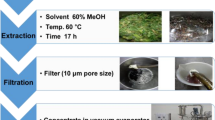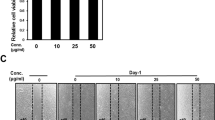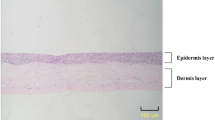Abstract
The use of microalgae in the skin care market is already established although the scientific rationale for their benefit was not clearly defined. In this work, the biological activities of dermatologic interest of the water extract from the microalga Botryococcus braunii (BBWE) were evaluated by a battery of in vitro assays. At concentrations ranging from 0.1 to 0.001 % (w/v) BBWE promoted adipocytes differentiation by inhibiting hormone-sensitive lipase, thus promoting triglyceride accumulation in the cells. BBWE also induced gene expression of proteins involved in the maintenance of skin cells water balance such as aquaporin-3 (AQP3), filaggrin (FLG) and involucrin (INV). 0.1 % BBWE increased the gene expression of AQP3 of 2.6-folds, that of FLG and INV of 1.5- and 1.9-folds, respectively. Moreover, it induced the biosynthesis of collagen I and collagen III by 80 and 40 %, respectively, compared to the untreated control. BBWE antioxidant activity, evaluated by oxygen radical absorbance capacity (ORAC) assay, was of 43.5 μmol Trolox per gram of extract: a quite high value among those found for other microalgae extracts. BBWE inhibited the inducible nitric oxide synthase (iNOS) gene expression and the consequent nitrite oxide (NO) production under oxidative stress. At a concentration of 0.02 % BBWE reduced by 50 % the expression of iNOS and by about 75 % the NO production. Taken together, the results demonstrated that B. braunii water extract exerted an array of biological activities concurring with the skin health maintenance; therefore, it is a potential bioactive ingredient to be included in cosmetic products.



Similar content being viewed by others
References
Bäckesjö CM, Li Y, Lindgren U, Haldosén LA (2006) Activation of Sirt1 decreases adipocyte formation during osteoblast differentiation of mesenchymal stem cells. J Bone Miner Res 21(7):993–1002
Bai L, Pang WJ, Yang YJ, Yang GS (2008) Modulation of Sirt1 by resveratrol and nicotinamide alters proliferation and differentiation of pig preadipocytes. Mol Cell Biochem 307:129–140
Baksh D, Song L, Tuan RS (2004) Adult mesenchymal stem cells: characterization, differentiation, and application in cell and gene therapy. J Cell Mol Med 8:301–316
Banerjee A, Sharma R, Chisti Y, Banerjee UC (2002) Botryococcus braunii: a renewable source of hydrocarbons and other chemicals. Crit Rev Biotechnol 22(3):245
Belfrage P, Fredrikson G, Strålfors P, Tornquist H (1984) Adipose tissue lipases. In: Borgström B, Brockman HL (eds) Lipases. Elsevier, Amsterdam, pp 365–416
Chkhikvishvili ID, Ramazanov ZM (2000) Phenolic substances of brown algae and their antioxidant activity. Appl Biochem Microbiol 36:289–291
Dale BA, Holbrook KA, Steinert PM (1978) Assembly of stratum corneum basic protein and keratin filaments in macrofibrils. Nature 276:729–731
Duan XJ, Zhang WW, Li XM, Wang BG (2006) Evaluation of antioxidant property of extract and fractions obtained from a red alga, Polysiphonia urceolata. Food Chem 95:37–43
Dulbecco R, Freeman G (1959) Plaque production by the Polyoma virus. Virology 8:396–397
Eckert RL, Welter JF (1996) Transcription factor regulation of epidermal keratinocyte gene expression. Mol Biol Rep 23:59–70
Eckert RL, Yaffe MB, Crish JF, Murthy S, Rorke EA, Welter JF (1993) Involucrin—structure and role in envelope assembly. J Invest Dermatol 100:613–617
Gouveia L, Raymundo A, Batista AP, Sousa I, Empis J (2006) Chlorella vulgaris and Haematococcus pluviales biomass as colouring and antioxidant in food emulsions. Eur Food Res Technol 222:362–367
Hara M, Ma T, Verkman AS (2002) Selectively reduced glycerol in skin of aquaporin-3-deficient mice may account for impaired skin hydration, elasticity, and barrier recovery. J Biol Chem 227:46616–46621
Hara-Chikuma M, Verkman AS (2008) Roles of aquaporin-3 in the epidermis. J Invest Dermatol 128:2145–2151
Harding CR, Scott IR (2002) Stratum corneum moisturizing factors. In: Leyden J, Rawlings A (eds) Skin moisturization. Marcel Dekker, New York, pp 61–80
Harding CR, Scott IR (1983) Histidine-rich proteins (filaggrins). Structural and functional heterogeneity during epidermal differentiation. J Mol Biol 170:651–673
Herrero M, Cifuentes A, Ibanez E (2006) Sub- and supercritical fluid extraction of functional ingredients from different natural sources: plants, food-by-products, algae and microalgae. A review. Food Chem 98:136–148
Herrero M, Martin-Alvarez PJ, Senorans FJ, Cifuentes A, Ibanez E (2005) Optimization of accelerated solvent extraction of antioxidants from Spirulina platensis microalga. Food Chem 93:417–423
Holm C (2003) Molecular mechanisms regulating hormone-sensitive lipase and lipolysis. Biochem Soc Trans 31(6):1120–1124
Hsu S, Dickinson D, Borke J (2007) Green tea polyphenol induces caspase 14 in epidermal keratinocytes via MAPK pathways and reduces psoriasiform lesions in the flaky skin mouse model. Exp Dermatol 16:678–684
Huang D, Ou B, Woodill MH, Flanagan JA, Prior RL (2002) High-throughput assay of oxygen radical absorbance capacity (ORAC) using a multichannel liquid handling system coupled with a microplate fluorescence reader in 96-well format. J Agric Food Chem 50:4437–4444
Huang HL, Wang BG (2004) Antioxidant capacity and lipophilic content of seaweeds collected from the Qingdao coastline. J Agric Food Chem 52:4993–4997
Ishida-Yamamoto A, Iizuka H (1998) Structural organization of cornified cell envelopes and alterations in inherited skin disorders. Exp Dermatol 7:1–10
Kam E, Resing KA, Lim S, Dale BA (1993) Identification of rat epidermal profilaggrin phosphatase as a member of the protein phosphatase 2A family. J Cell Sci 106:219–226
Karsenty G, Park RW (1995) Regulation of type I collagen genes expression. Int Rev Immunol 12:177–185
Koch PJ, Viragh PA, Scharer E, Bundman D, Longley MA, Bickenbach J, Kawachi Y, Suga Y, Zhou Z, Huber M, Hohl D, Kartasova T, Jarnik M, Steven AC, Roop DR (2000) Lessons from loricrin-deficient mice: compensatory mechanisms maintaining skin barrier function in the absence of a major cornified envelope protein. J Cell Biol 151:389–400
Kolios G, Valatas V, Ward SG (2004) Nitric oxide in inflammatory bowel disease: a universal messenger in an unsolved puzzle. Immunol 113:427–437
Kramer U, Schikowski T (2006) Recent demographic changes and consequences in dermatology. In: Gilchrest BA, Krutmann J (eds) Skin ageing. Springer, Berlin, pp 1–8
Krutmann J (2001) New developments in photoprotection of human skin. Skin Pharmacol Appl Skin Physiol 14:401–407
Kuda T, Tsunekawa M, Hishi T, Araki Y (2005) Antioxidant properties of dried ‘kayamo-nori, a brown alga Scytosiphon lomentaria (Scytosiphonales, Phaeophyceae). Food Chem 89:617–622
Langin’ D, Holm C, Lafontan M (1996) Adipocyte hormone-sensitive lipase: a major regulator of lipid metabolism. Proc Nutr Soc 55:93–109
Li HB, Cheng KW, Wong CC, Fan KW, Chen F, Jiang Y (2007) Evaluation of antioxidant capacity and total phenolic content of different fractions of selected microalgae. Food Chem 102:771–776
Li HB, Chen F, Zhang TY, Yang FQ, Xu GQ (2001) Preparative isolation and purification of lutein from the microalga Chlorella vulgaris by high-speed counter-current chromatography. J of Chromatogr A 905:151–155
Lim SW, Hong SP, Jeong SW, Kim B, Bak H, Ryoo HC, Lee SH, Ahn SK (2007) Simultaneous effect of ursolic acid and oleanolic acid on epidermal permeability barrier function and epidermal keratinocyte differentiation via peroxisome proliferator-activated receptor-alpha. J Dermatol 34:625–634
Lowenstein CJ, Alley EW, Raval P, Snowman AM, Snyder SH, Russell SW, Murphy WJ (1993) Macrophage nitric oxide synthase gene: two upstream regions mediate induction by interferon and lipopolysaccharide. Proc Natl Acad Sci USA 90(2):9730–9734
Marionnet C, Vioux-Chagnoleau C, Pierrard C, Sok J, Asselineau D, Bernerd F (2006) Morphogenesis of dermal-epidermal junction in a model of reconstructed skin: beneficial effects of vitamin C. Exp Dermatol 15:625–633
Marks R (2004) The stratum corneum barrier: the final frontier. J Nutr 134:2017S–2021S
Monzon RI, LaPres JJ, Hudson LG (1996) Regulation of involucrin gene expression by retinoic acid and glucocorticoids. Cell Growth Differ 7:1751–1759
Morimoto C, Kameda K, Tsujita T, Okuda H (2001) Relationships between lipolysis induced by various lipolytic agents and hormone-sensitive lipase in rat fat cells. J Lipid Res 42:120–127
Murthy KNC, Vanitha A, Rajesha J, Swamy MM, Sowmya PR, Ravishankar GA (2005) In vivo antioxidant activity of carotenoids from Dunaliella salina—a green microalga. Life Sci 76:1381–1390
Pereda MCV, Dieamant GC, Eberlin S, Werka RM, Colombi D, Queroz MLS, Di Stasi LC (2010) Expression of differential genes involved in the maintenance of water balance in human skin by Piptadenia colubrina extract. J Cosmet Dermatol 9:35–43
Picard F, Kurtev M, Chung N, Topark-Ngarm A, Senawong T, Machado De Oliveira R, Leid M, McBurney MW, Guarente L (2004) Sirt1 promotes fat mobilization in white adipocytes by repressing PPAR-gamma. Nat 429:771–776
Plaza M, Cifuentes A, Ibanez E (2008) In the search of new functional food ingredients from algae. Trend Food Sci Technol 19:31–39
Plaza M, Santoyo S, Jaime L, Garcia-Blairsy Reina G, Herrero M, Senoransb FJ, Ibaneza E (2010) Screening for bioactive compounds from algae. J Pharm Biomed Anal 51:450–455
Porcu M, Chiarugi A (2005) The emerging therapeutic potential of sirtuin-interacting drugs: from cell death to lifespan extension. Trends Pharmacol Sci 26:94–103
Quan T, Qin Z, Shao Y, Xu Y, Voorhees JJ, Fisher GJ (2011) Retinoids suppress cysteine-rich protein 61 (CCN1), a negative regulator of collagen homeostasis, in skin equivalent cultures and aged human skin in vivo. Exp Dermatol 20:572–576
Resing KA, Walsh KA, Haugen-Scofield J, Dale BA (1989) Identification of proteolytic cleavage sites in the conversion of profilaggrin to filaggrin in mammalian epidermis. J Biol Chem 264:1837–1845
Sauve AA, Moir RD, Schramm VL, Willis IM (2005) Chemical activation of Sir2-dependent silencing by relief of nicotinamide inhibition. Mol Cell 17:595–601
Senousy HH, Beakes GW, Hack E (2004) Phylogenetic placement of Botryococcus braunii (Trebouxiophyceae) and Botryococcus sudeticus isolate UTEX 2629 (Chlorophyceae). J Phycol 40:412–423
Sougrat R, Morand M, Gondran C, Barre P, Gobin R, Bonte F, Dumas M, Verbanaz JM (2002) Functional expression of AQP3 in human skin epidermis and reconstructed epidermis. J Invest Dermatol 118:678–685
Steinert PM, Marekov LN (1997) Direct evidence that involucrin is a major early isopeptide crosslinked component of the keratinocyte cornified cell envelope. J Biol Chem 272:2021–2030
Stolz P, Obermayer B (2005) Manufacturing microalgae for skin care. Cosmet Toilet 120:99–106
Talvvar SH, Christopher EM, Fisher GJ, Hamilton TA, Voorhees JJ (1995) Reduced type I and type III procollagens in photodamaged adult human skin. J Invest Dermatol 105:285–290
Tannin-Spitz T, Bergman M, Van-Moppes D, Grossman S, Arad S (2005) Antioxidant activity of the polysaccharide of the red microalga Porphyridium sp. J Appl Phycol 17:215–222
Tito A, Carola A, Bimonte M, Barbulova A, Arciello S, De Laurentiis F, Monoli I, Hill J, Gibertoni S, Colucci G, Apone F (2011) A tomato stem cell extract, containing antioxidant compounds and metal chelating factors, protects skin cells from heavy metal-induced damages. Int J Cosmet Sci 33:543–552
Verkman AS (2008) A cautionary note on cosmetics containing ingredients that increase aquaporin-3 expression. Exp Dermatol 17:871–872
Vermeer BJ, Gilchrest BA (1996) Cosmeceuticals. A proposal for rational definition, evaluation, and regulation. Arch Dermatol 132:337–340
Voss KE, Bollag RJ, Fussell N, By C, Sheehan DJ, Bollag WB (2011) Abnormal aquaporin-3 protein expression in hyperproliferative skin disorders. Arch Dermatol Res 303:591–600
Watson AL, Fray TR, Bailey J, Baker CB, Beyer SA, Markwell PJ (2006) Dietary constituents are able to play a beneficial role in canine epidermal barrier function. Exp Dermatol 15:74–81
Xie QW, Whisnant R, Nathan C (1993) Promoter of the mouse gene encoding calcium-independent nitric oxide synthase confers inducibility by interferon and bacterial lipopolysaccharide. J Expl Med 177(6):1779–1784
Yasui H, Kubota M, Iguchi K, Usui S, Kiho T, Hirano K (2008) Membrane trafficking of aquaporin 3 induced by epinephrine. Biochem Biophys Res Commun 373:613–617
Yarosh DB, Galvin JW, Nay SL, Penã AV, Canning MT, Brown DA (2006) Anti-inflammatory activity in skin by biomimetic of Evodia rutaecarpa extract from traditional Chinese medicine. J Dermatol Sci 42:13–21
Zhang QB, Yu PZ, Li Z, Zhang H, Xu ZH, Li PC (2003) Antioxidant activities of sulfate polysaccharide fractions from Porphyra haitanensis. J Appl Phycol 15:305–310
Acknowledgments
This work was carried out in the framework of the project “Phytocosmetics: cosmetic formulations based on water-soluble extracts from microalgae with replenishing action on skin tissue” funded by Institute of Foreign Commerce (ICE) and Conference of Italian University Rectors (CRUI).
Conflict of interest
The authors have no conflict of interests to declare.
Author information
Authors and Affiliations
Corresponding author
Rights and permissions
About this article
Cite this article
Buono, S., Langellotti, A.L., Martello, A. et al. Biological activities of dermatological interest by the water extract of the microalga Botryococcus braunii . Arch Dermatol Res 304, 755–764 (2012). https://doi.org/10.1007/s00403-012-1250-4
Received:
Revised:
Accepted:
Published:
Issue Date:
DOI: https://doi.org/10.1007/s00403-012-1250-4




